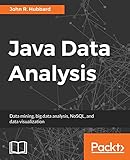Java data analysis
By: Hubbard, John R
Publisher: Munbai ; Birmingham Packt Publishing : 2017.Description: 384p. : ill. ; 28 cm.ISBN: 9781787285651Subject(s): Data Preprocessing | Polynomial regressionDDC classification: 005.133 HU JA Online resources: Location Map| Item type | Home library | Call number | Status | Date due | Barcode | Item holds |
|---|---|---|---|---|---|---|
| REGULAR | University of Wollongong in Dubai Main Collection | 005.133 HU JA (Browse shelf) | Available | T0057694 |
, Shelving location: Main Collection Close shelf browser

|

|

|

|

|

|

|
||
| 005.133 HO JA Big Java : | 005.133 HO OB Object-oriented programming with Java / | 005.133 HO PY Python for Everyone | 005.133 HU JA Java data analysis | 005.133 HU SC Schaum's outline of theory and problems of data structures with C++ / | 005.133 HU SC Schaum's outline of theory and problems of programming with C++ / | 005.133 HU SC Schaum's outline of theory and problems of programming with C++ / |
Cover; Copyright; Credits; About the Author; About the Reviewers; www.PacktPub.com; Customer Feedback; Table of Contents; Preface; Chapter 1: Introduction to Data Analysis; Origins of data analysis; The scientific method; Actuarial science; Calculated by steam; A spectacular example; Herman Hollerith; ENIAC; VisiCalc; Data, information, and knowledge; Why Java?; Java Integrated Development Environments; Summary; Chapter 2: Data Preprocessing; Data types; Variables; Data points and datasets; Null values; Relational database tables; Key fields; Key-value pairs; Hash tables; File formats Microsoft Excel dataXML and JSON data; Generating test datasets; Metadata; Data cleaning; Data scaling; Data filtering; Sorting; Merging; Hashing; Summary; Chapter 3: Data Visualization; Tables and graphs; Scatter plots; Line graphs; Bar charts; Histograms; Time series; Java implementation; Moving average; Data ranking; Frequency distributions; The normal distribution; A thought experiment; The exponential distribution; Java example; Summary; Chapter 4: Statistics; Descriptive statistics; Random sampling; Random variables; Probability distributions; Cumulative distributions The binomial distributionMultivariate distributions; Conditional probability; The independence of probabilistic events; Contingency tables; Bayes' theorem; Covariance and correlation; The standard normal distribution; The central limit theorem; Confidence intervals; Hypothesis testing; Summary; Chapter 5: Relational Databases; The relation data model; Relational databases; Foreign keys; Relational database design; Creating a database; SQL commands; Inserting data into the database; Database queries; SQL data types; JDBC; Using a JDBC PreparedStatement; Batch processing; Database views SubqueriesTable indexes; Summary; Chapter 6: Regression Analysis; Linear regression; Linear regression in Excel; Computing the regression coefficients; Variation statistics; Java implementation of linear regression; Anscombe's quartet; Polynomial regression; Multiple linear regression; The Apache Commons implementation; Curve fitting; Summary; Chapter 7: Classification Analysis; Decision trees; What does entropy have to do with it?; The ID3 algorithm; Java Implementation of the ID3 algorithm; The Weka platform; The ARFF filetype for data; Java implementation with Weka; Bayesian classifiers Java implementation with WekaSupport vector machine algorithms; Logistic regression; K-Nearest Neighbors; Fuzzy classification algorithms; Summary; Chapter 8: Cluster Analysis; Measuring distances; The curse of dimensionality; Hierarchical clustering; Weka implementation; K-means clustering; K-medoids clustering; Affinity propagation clustering; Summary; Chapter 9: Recommender Systems; Utility matrices; Similarity measures; Cosine similarity; A simple recommender system; Amazon's item-to-item collaborative filtering recommender; Implementing user ratings; Large sparse matrices.
Data analysis is a process of inspecting, cleansing, transforming, and modeling data with the aim of discovering useful information. Java is one of the most popular languages to perform your data analysis tasks.
This book will help you learn the tools and techniques in Java to conduct data analysis without any hassle. After getting a quick overview of what data science is and the steps involved in the process, you'll learn the statistical data analysis techniques and implement them using the popular Java APIs and libraries. Through practical examples, you will also learn the machine learning concepts such as classification and regression.
In the process, you'll familiarize yourself with tools such as Rapidminer and WEKA and see how these Java-based tools can be used effectively for analysis. You will also learn how to analyze text and other types of multimedia. Learn to work with relational, NoSQL, and time-series data. This book will also show you how you can utilize different Java-based libraries to create insightful and easy to understand plots and graphs.
By the end of this book, you will have a solid understanding of the various data analysis techniques, and how to implement them using Java.
